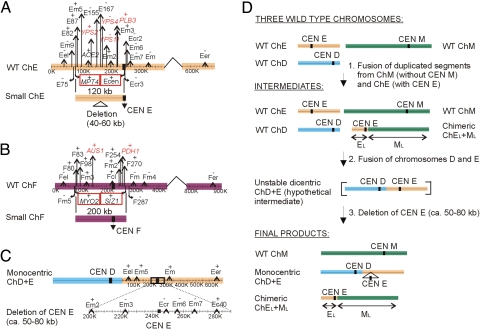Fig. 3.
Segmental duplications involved in the origin of novel chromosomes. (A) Y624 carries a duplication of chromosome E corresponding to a ≈120-kb fragment, which has subsequently deleted a 40- to 60-kb segment. (B) Y663 carries a duplication of chromosome F corresponding to ≈200 kb. Black stripes symbolize the position of centromeres (CEN). WT stands for CBS 138 chromosome architecture. The last genes identified as present on the novel chromosomes are marked by red squares. The previously described genes involved in virulence or drug resistance are marked in red. (C) CBS 138 chromosome D and E fusion found in Y622. Note a large deletion in the CEN E region. (D) A model illustrating the origin of the chromosome D and E fusion found in Y622. The centromere (CEN) of the original chromosome E (ChE) was removed by a deletion of a ≈50- to 80-kb region, thereby eliminating a dicentric chromosome structure. The deleted region also covering centromere E was retained on chimeric chromosome composed of the left arm of chromosome E and the left arm of chromosome M. The centromere E fragment in the chimeric chromosome is of a larger size as the region deleted around centromere E in the monocentric D plus E chromosome.

